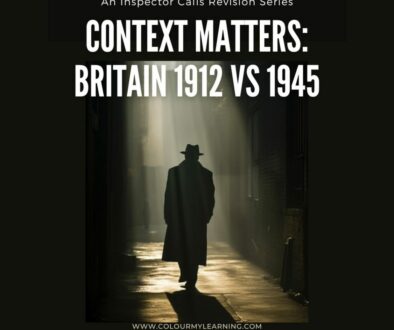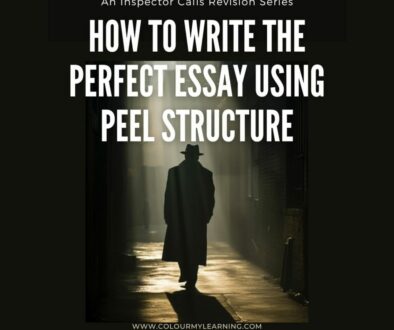IGCSE Physics Forces and Motion Past Papers Exam Questions (Edexcel): 2019-22
We analysed the Edexcel International GCSE past papers and grouped the questions by topic. Here, you will find questions relating to the topic – Forces and motion. Use these to familiarise, practice and prepare for your IGCSE Physics examination.
You can find more IGCSE Physics Past Year Questions by the Wave topic below:
- Waves Past Papers from 2019 to 2020
- Waves Past Papers from 2021 to 2022
- Waves Past Papers from 2023 to 2024
What you need to know
Use the list below as a quick recap for what you need to know before attempting the past year exam questions under this topic. This is based on Edexcel International GCSE in Physics (4PH1) specification with first teaching Sept 2017 and first examination June 2019.
Paper 1 and 2: (1) Forces and motion
Paper 1 covers the all the topics below except where marked “Paper 2 only”. Paper 2 covers all topics.
A. Units
- kilogram (kg), metre (m), metre/second (m/s), metre/second2 (m/s2), newton (N), second (s) and newton/kilogram (N/kg)
- newton metre (Nm), kilogram metre/second (kg m/s)
B. Movement and position
- be able to plot and explain distance-time graphs
- the relationship between average speed, distance and time. average speed = distance moved / time taken
- practical: investigate motion of everyday objects such as toy cars or tennis balls
- the relationship between acceleration, change in velocity over time taken. a = (v − u)/ t
- plot and explain velocity-time graphs, use them to calculate acceleration (gradient) and distance travelled (area under line)
- the relationship between final speed, initial speed, acceleration and distance moved. v2 =u2 +(2×a×s)
C. Forces, movement, shape and momentum
- describe the effects of forces that act on bodies.
- identify different types of forces. (gravitational or electrostatic)
- difference between vector quantities and scalar quantities.
- force is a vector quantity.
- be able to calculate resultant force that act along a line.
- know that friction is a force that opposes motion.
- relationship between unbalanced force, mass and acceleration. F=m×a
- relationship between weight, mass and gravitational field strength. W=m×g
- stopping distance of a car is the sum of thinking and braking distances
- describe the factors that affect stopping distance (speed, mass, road condition, reaction time)
- describe the forces that act on falling objects
- explain why a falling object reaches terminal velocity
- practical: investing how extension varies with applied force for helical springs, metal wires and rubber bands
- Hooke’s Law and elastic behaviour. (ability to recover its original shape)
(Paper 2 Only)
- the relationship between momentum, mass and velocity. p=m×v
- use the idea of momentum to explain safety features
- use the conservation of momentum to calculate mass, velocity and momentum
- the relationship between force, change in momentum and time taken. F = (mv − mu)/ t
- Newton’s Third Law
- Moment = force x perpendicular distance from the pivot
- weight of an object acts through its centre of gravity
- use principle of moments to analyse the parallel forces acting in one plane
- how upward forces on a light beam, supported at its ends, vary with the position of a heavy object placed on the beam.
June 2019 Paper 1 Q4
4. A car driver sees a hazard on the road ahead.
The graph shows the velocity of the car from when the driver sees the hazard.
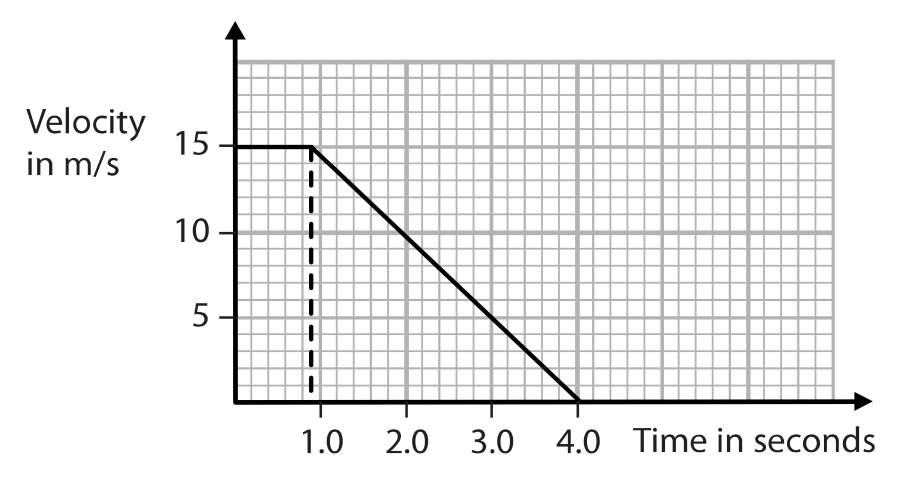
(a)(i) Use the graph to determine the reaction time of the driver. (1)
reaction time = …………………………………….s
(ii) Calculate the stopping distance of the car. (4)
stopping distance = …………………………………….m
(ii) Calculate the acceleration of the car when the car is braking. (4)
acceleration = …………………………………….m/s2
(b)The speed of the car affects the thinking distance and the braking distance.
(Total for Question 4 = 12 marks)
June 2019 Paper 1PR Q7 & 8
7 A student investigates how the surface material of a ramp affects the average speed of a block sliding down the ramp.
(a) Design a suitable method for the student’s investigation. Your answer should include
- the measuring equipment needed
- details of the independent, dependent and control variables
- how the average speed will be determined
You may include a diagram to help your answer. (6)
(b) Justify why the student should display their results as a bar chart. (1)
(Total for Question 7 = 7 marks)
8 The graph shows how the velocity of a parachute jumper changes with time.
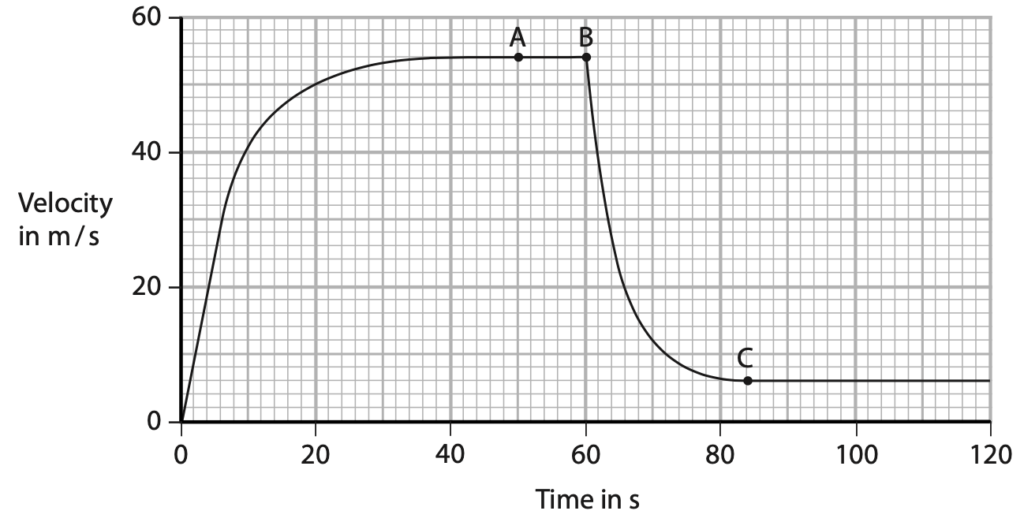
(a) At point A, the parachute jumper is falling at terminal velocity and has not yet opened her parachute.
(i) Which statement is correct about the parachute jumper at point A? (1)
A acceleration and air resistance are equal
B acceleration and velocity are equal
C weight and acceleration are equal
D weight and air resistance are equal
(ii) Which is the best estimate of the distance fallen by the parachute jumper from the start until point A? (1)
A 50m
B 1300m
C 2300m
D 2700m
(b) The parachute jumper opens her parachute at point B.
Her velocity decreases until she reaches terminal velocity again at point C.
Explain this change in velocity.
(c) After point C, the parachute jumper continues to fall at a constant velocity.
As she falls, energy is transferred from a gravitational store.
Which store is the energy transferred into? (1)
A chemical store
B gravitational store
C kinetic store
D thermal store
(Total for Question 8 = 7 marks)
January 2020 Paper 1 Q8 & 10
8 A car is moving along a road.
(a) The car has an initial velocity of 26 m / s.
The car then accelerates at 1. 2 m / s2 until it reaches a velocity of 35 m / s.
(i) State the formula linking acceleration, change in velocity and time taken. (1)
(ii) Calculate the time taken for the car to accelerate to 35 m/s. (3)
time = …………………………………………………….. s
(c) A radar speed gun is used to measure the speed of the moving car.
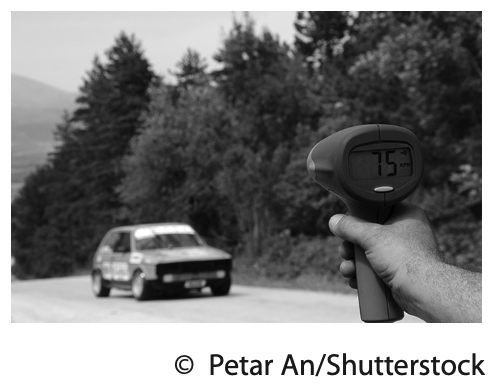
The radar speed gun emits radio waves towards the moving car.
The moving car reflects the radio waves back to a detector on the gun.
The detected radio waves have a different frequency from the emitted radio waves.
This change in frequency is used to measure the speed of the moving car.
Explain this change in frequency when the car is moving towards the radar speed gun. (4)
(Total for Question 8 = 8 marks)
10 (a) Diagram 1 shows a van accelerating along a horizontal road.
The horizontal forces acting on the van are shown.

(i) Force X opposes the motion of the van.
State the name of force X.(1)
(ii) The resultant force acting on the van is 1500 N.
Calculate the magnitude of force X. (1)
[assume X is the only horizontal force opposing the motion of the van]
(b) Diagram 2 shows the resultant force acting on the van when it brakes.

(i) State the formula linking resultant force, mass and acceleration. (1)
(ii) The mass of the van is 1900 kg.
Calculate the acceleration of the van when it brakes.
Give the unit. (3)
acceleration = ……………………………………….. unit ……………………………………….
(iii) The van was travelling at an initial speed of 18 m/s before braking and coming to rest.
Calculate the distance travelled by the van while it is braking.
[assume that the acceleration remains constant] (3)
distance travelled = ……………………………………….. m
(iv) Describe two factors that would increase the braking distance. (2)
(c) When the van is fully loaded its mass increases to 2500 kg.
Calculate the time taken to bring the fully loaded van to rest when it is travelling at an initial speed of 18 m/s.
[assume that the resultant force during braking remains at 14 kN] (4)
time = ……………………………………….. s
(Total for Question 10 = 15 marks)
June 2019 Paper 2 Q8
8 The diagram shows a bottle supported by a finger.
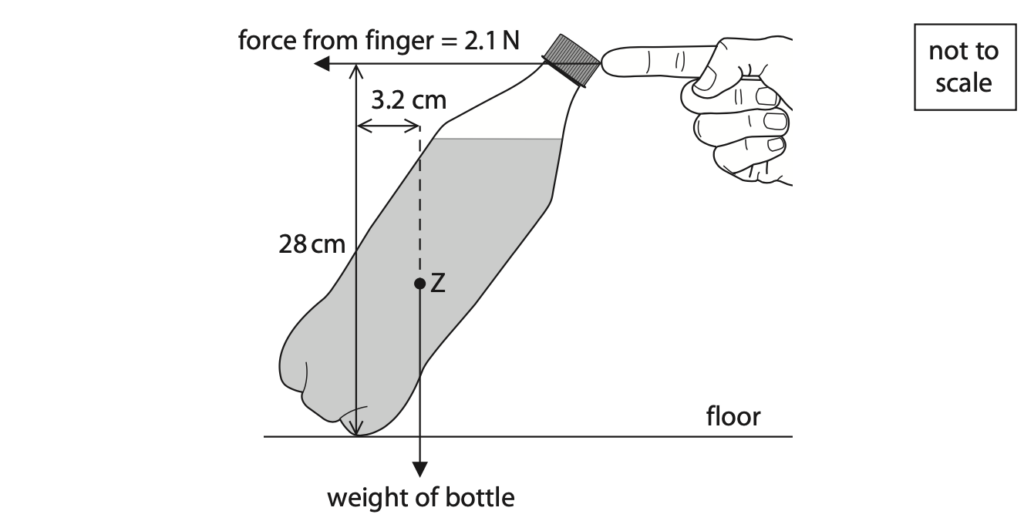
(a) State the name of point Z. (1)
(b) (i) State the formula linking moment, force and perpendicular distance from the pivot. (1)
(ii) The bottle does not move. Calculate the weight of the bottle. (4)
weight of bottle = …………………………………………………….. N
Total for Question 8 = 6 marks
June 2019 Paper 2PR Q7
7 A game is played on a table with balls of different colours.
(a) The diagram shows the white ball moving across a flat surface.

(i) State the formula linking momentum, mass and velocity. (1)
(ii) The white ball has a mass of 170 g.
Calculate the momentum of the white ball. (2)
momentum = ……………………………………….. kgm/s
(b) The white ball collides with a stationary black ball.

(i) The black ball has a mass of 160 g
After the collision, the black ball moves away from the white ball with a velocity of 5.0m/s.
Calculate the velocity of the white ball after the collision. (4)
velocity of white ball = ……………………………………….. m/s
(ii) During the collision, the white ball exerts a force of 80 N on the black ball.
The direction of this force is to the right.
State the magnitude and direction of the force the black ball exerts on the white ball during the collision. (2)
magnitude of force = ……………………………………….. N
direction of force = ………………………………………..
Total for Question 7 = 9 marks)
January 2020 Paper 1 Q2
2 A ship floats on the sea.
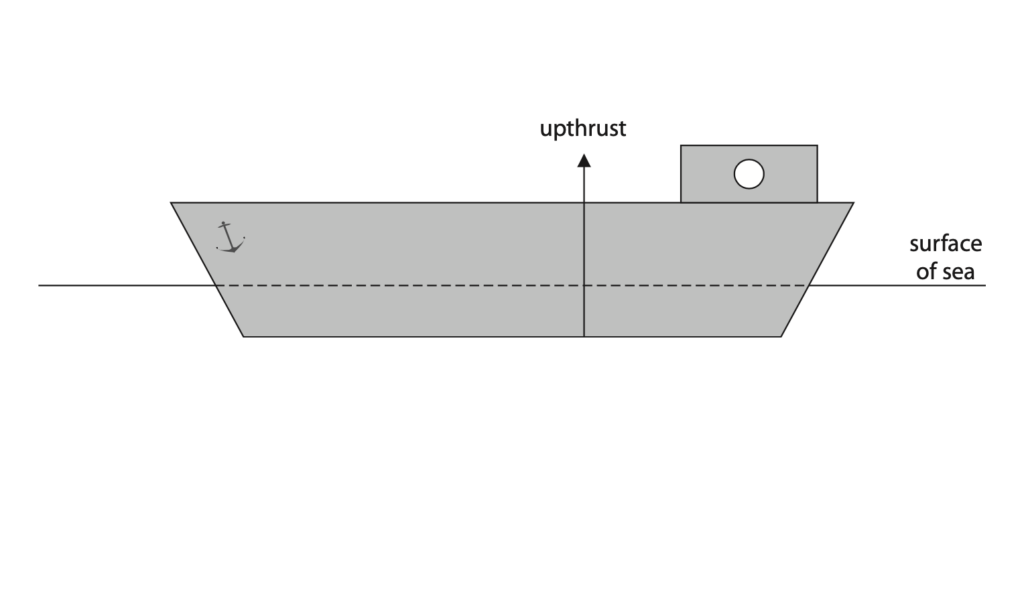
(a) The ship floats because of the forces acting on it.
(i) The upward force acting on the ship is called upthrust. This force is shown on the diagram.
Draw another labelled arrow on the diagram to show the other vertical force acting on the ship. (2)
(ii) Forces are vector quantities.
State what is meant by the term vector quantity. (2)
(iii) Give another example of a vector quantity. (1)
(b) The upthrust force acting on the ship is proportional to the pressure difference between the bottom of the ship and the surface of the sea.
The pressure acting on the ship at the surface of the sea is 100 kPa.
(i) State the formula linking pressure difference, height, density and gravitational field strength (g). (1)
(ii) The bottom of the ship is 15.8 m below the surface of the sea.
Show that the pressure acting on the bottom of the ship is approximately 260 kPa. (3)
[density of seawater = 1030 kg/m3]
(iii) Explain why the bottom of the ship is deeper below the surface of the sea when the ship is fully loaded with cargo. (2)
(Total for Question 2 = 11 marks)
January 2020 Paper 1 Q5
5. A bus transports passengers.
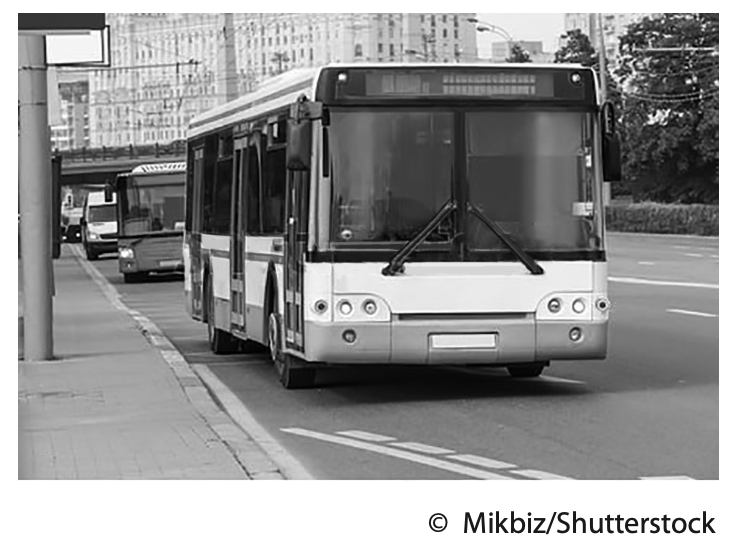
(a) The bus stops at certain points in its journey to let passengers get on or off the bus.
The distance-time graph shows part of the bus journey, with sections labelled A to G.
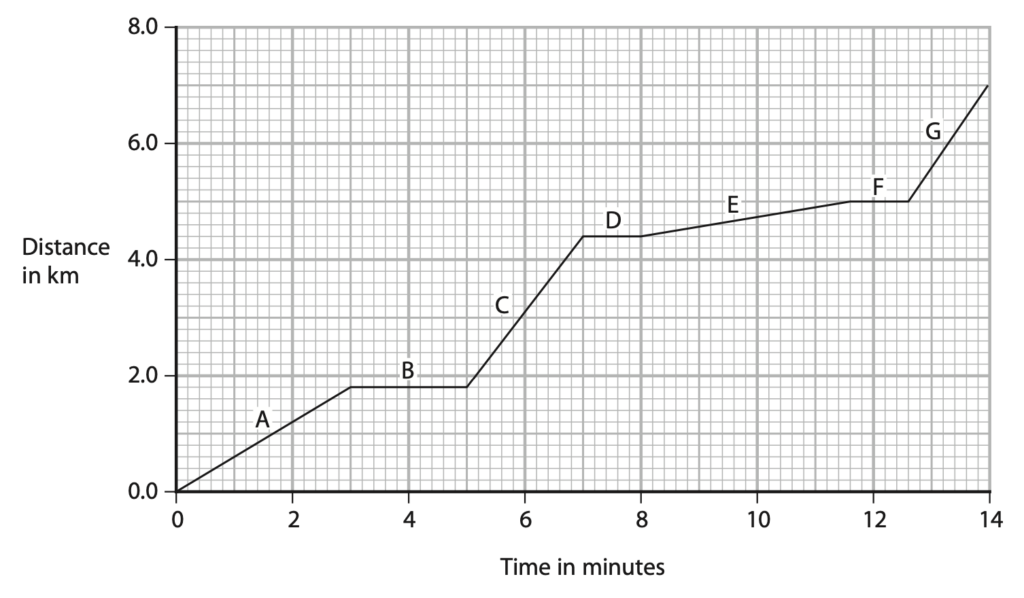
(i) Give the letters of the sections where the bus is stationary. (1)
(ii) Calculate the speed of the bus during section C of the journey.
Give your answer in m / s. (4)
speed = …………………………………………………….. m/s
(iii) Explain what the graph shows about the speed of the bus in section E compared with the speed of the bus in section A. (2)
(b) Another bus travels a distance of 7.0 km in a time of 14 minutes.
This bus travels at a constant velocity.
Complete the velocity-time graph to show the motion of this bus. (2)

(Total for Question 5 = 9 marks)
January 2020 Paper 1PR Q3
3 The diagram shows a truck travelling along a horizontal road. BOOYAH

(a) The driver sees an obstacle in the road and then applies the brakes.
(i) Which of these factors affects thinking distance? (1)
A condition of the tyres
B consumption of alcohol by the driver
C mass of the vehicle
D condition of the road
(ii) Which of these factors affects both thinking distance and braking distance? (1)
A condition of the brakes
B condition of the road
C mass of the vehicle
D speed of the vehicle
(b) The truck experiences a braking force of 46 000 N.
(i) State the formula linking work done, force and distance moved. (1)
(ii) The truck has 590 000 J of energy in its kinetic energy (KE) store before the driver applies the brakes.
The braking force does work on the truck to reduce the KE store of the truck to 0 J.
The braking distance is defined as the distance required for the KE store of the truck to reduce to 0 J when the brakes are applied.
Calculate the braking distance of the truck. (3)
distance = …………………………………………………….. m
(c) The brakes increase in temperature when the truck is braking.
(i) State the name of the energy store that has increased for the brakes.(1)
(ii) State the method of energy transfer from the truck to the brakes. (1)
(Total for Question 3 = 8 marks)
January 2020 Paper 1PR Q5
5 A table tennis ball is a very light plastic ball filled with air.
(a) A student drops a table tennis ball from rest.
The ball falls 13 m to the ground.
Show that the final speed of the ball, just before it reaches the ground, should be about 16 m/s.
Assume that there is no air resistance. (3)
(b) The student suggests that the ball will reach the ground with a speed that is less than 16 m/s because of air resistance.
Use ideas about forces to justify the student’s suggestion. (5)
(Total for Question 5 = 8 marks)
January 2020 Paper 2P Q3
3 Curling is a sport played on ice.
A player slides stone A across the ice towards a scoring zone.
The ice reduces friction so that there is negligible friction when the stone is sliding.
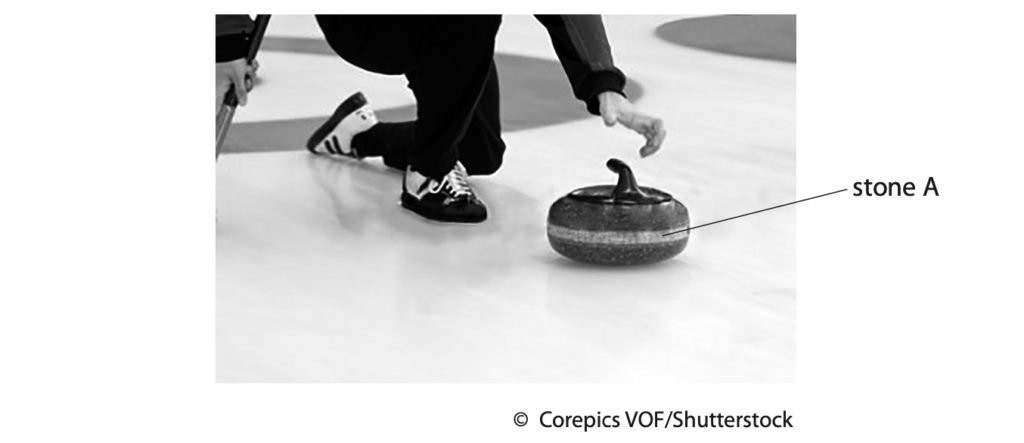
(a) Stone A leaves the player’s hand with a velocity of 2.90 m/s.
The mass of stone A is 17 kg.
(i) State the formula linking momentum, mass and velocity. (1)
(ii) Show that the momentum of stone A is approximately 50 kg m/s. (2)
(b) Stone A slides towards the scoring zone.
In the scoring zone, stone A collides with a stationary stone, B.
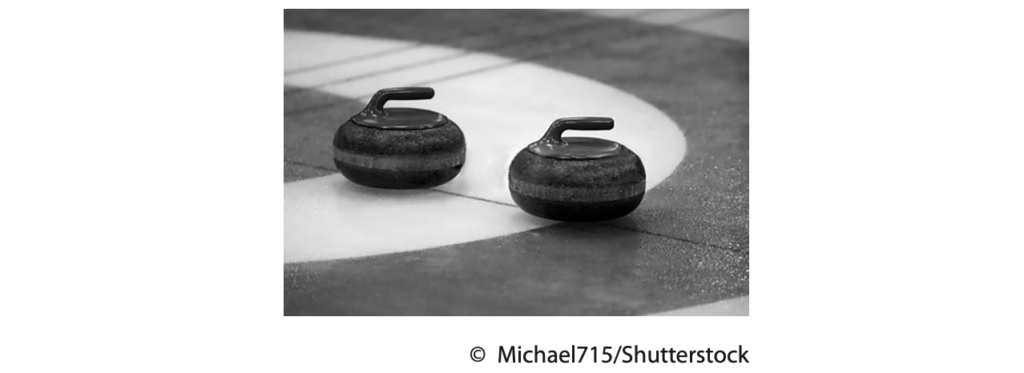
(i) After the collision, both stones move in the same direction as the initial direction of stone A.
The velocity of stone A after the collision is 0.40 m/s.
Calculate the velocity of stone B after the collision. (4)
[mass of stone B = 19 kg]
velocity of stone B = …………………………………………………….. m/s
(ii) When the stones collided, they were in contact for a time of 25 ms.
Calculate the magnitude of the force stone A exerted on stone B in this collision. (3)
force = …………………………………………………….. N
(Total for Question 3 = 10 marks)
January 2020 Paper 2PR Q2
2 This question is about a folding table.
The diagram shows some of the forces acting on the table.
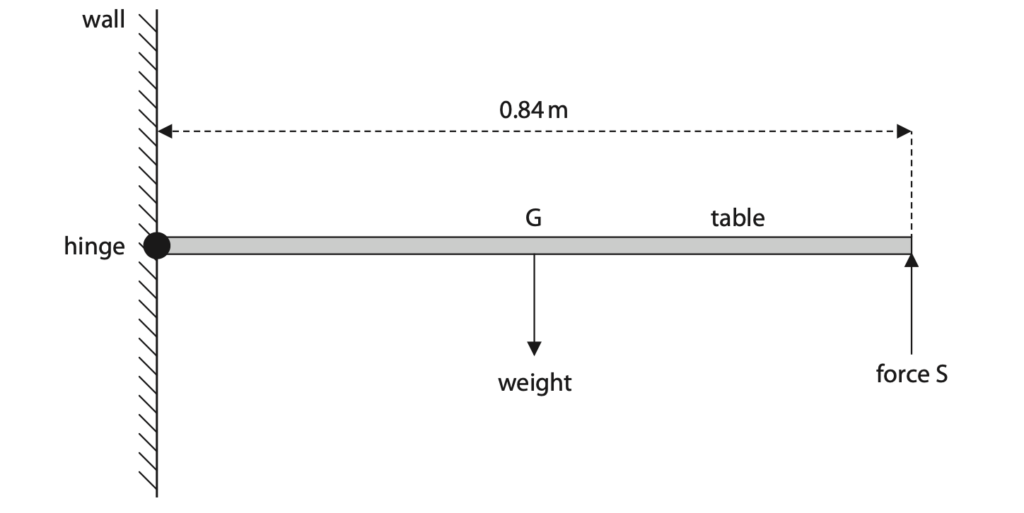
(a) The weight of the table acts through point G.
State the name of point G. (1)
(b) State the formula linking moment, force and perpendicular distance from the pivot. (1)
(c) The moment of the weight force of the table about the hinge is 92Nm.
By using the principle of moments, calculate the force S that a person applies to keep the table in equilibrium. (3)
force S = ……………………………………….N
(d) State Newton’s third law. (1)
(e) State the magnitude and the direction of the force that the table applies to the
person holding the table.(2)
magnitude = ……………………………………….. N
direction = ……………………………………….
(Total for Question 2 = 8 marks)
January 2020 Paper 2PR Q3
3 This question is about momentum.
Diagram 1 shows a neutron approaching a uranium-235 nucleus.
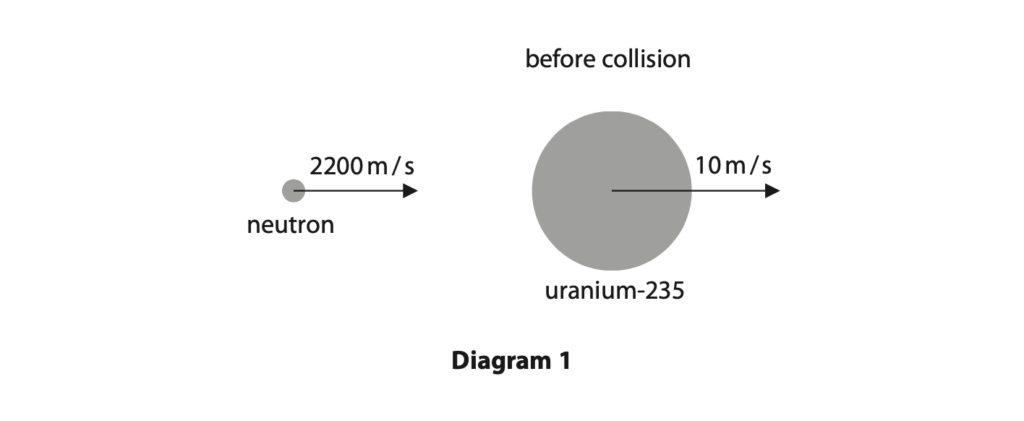
(a) State the formula linking momentum, mass and velocity. (1)
(b) Calculate the momentum of the neutron.
Give a unit with your answer. (3)
[mass of neutron = 1.67 × 10–27 kg]
momentum = ………………………………………. unit ……………………………………..
(c) State what is meant by the term conservation of momentum. (1)
(d) Diagram 2 shows that when the neutron collides with the uranium-235 nucleus, they combine to give a uranium-236 nucleus.
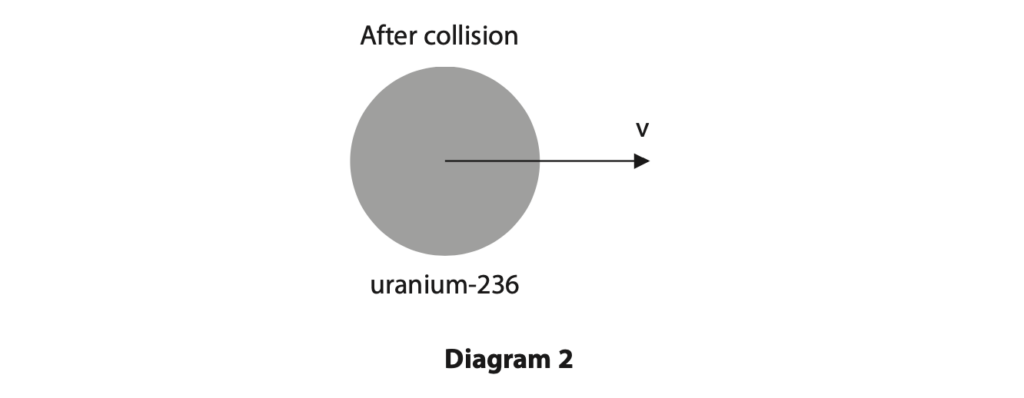
Use conservation of momentum to calculate the velocity, v, of the uranium-236 nucleus. (4)
[mass of uranium-235 nucleus = 3.99 × 10–25 kg]
[mass of uranium-236 nucleus = 4.01 × 10–25 kg]
v = ………………………………………. m/s
(Total for Question 3 = 9 marks)
June 2020 Paper 1P Q4
4 (a) (i) State Hooke’s Law. (2)
(ii) The graph shows how the extension of a rubber band varies with the force applied.

(b) Diagram 1 shows a model aeroplane powered by a rubber band.

A person rotates the propeller of the model aeroplane, which twists the rubber band.
He then releases the propeller and it spins.
Energy transfer occurs during this process.
The box lists words associated with energy.
| kinetic | gravitational | electrostatic |
| mechanical | elastic | magnetic |
| heating | chemical | radiation |
Use words from the box to complete the passage. (3)
The person does ………………………………………………………………………………… work to twist the rubber band. As the person twists the rubber band it extends, increasing the ………………………………………………………………………… energy store of the rubber band. When the rubber band is released it does mechanical work, increasing the ………………………………………………………………………………… energy store of the propeller.
(c) Diagram 2 shows the aeroplane flying horizontally to the right.

The aeroplane flies at a constant speed.
Diagram 2 shows two forces acting on the aeroplane.
Draw labelled arrows on diagram 2 to show two more forces acting on the aeroplane. (4)
(Total for Question 4 = 11 marks)
June 2020 Paper 1P Q7
7 This is a question about Io, a moon of Jupiter.
The diagram shows two jets of gas from volcanoes on Io.
One jet of gas is from the volcano Prometheus and the other is from the volcano Tvashtar.
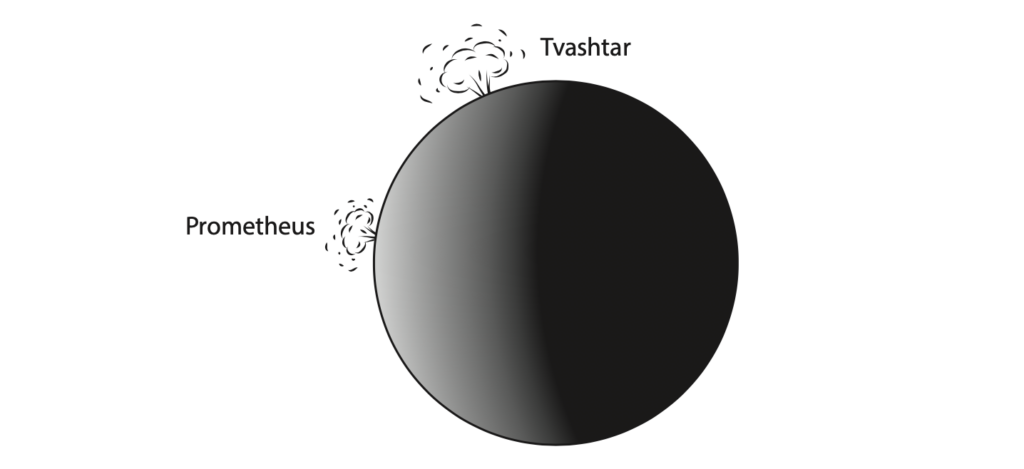
(a) Gas particles in the Prometheus jet leave the surface of Io and move vertically upwards.
The particles reach their maximum height when their speed is zero.
Some particles in the Prometheus jet reach a maximum height of 92 km.
Calculate the initial speed of these particles as they leave the surface of Io. (3)
[acceleration due to gravity on Io = 1.8 m/s2]
initial speed = ………………………………………… m/s
(b) Before the gas particles leave the surface of Io, they are trapped in a chamber.

(i) Explain how the gas particles exert a pressure on the walls of the chamber. (3)
(ii) The Tvashtar chamber has the same volume as the Prometheus chamber and contains the same number of molecules of the same type of gas.
The temperature of the gas in the Prometheus chamber is 1200 K.
The temperature of the gas in the Tvashtar chamber is 1600 K.
The pressure of the gas in the Prometheus chamber is 8.2 kPa.
Calculate the pressure of the gas in the Tvashtar chamber. (3)
pressure = ………………………………………… kPa
(iii) Explain why the pressure inside the chambers increases when the temperature increases.
Use ideas about particles in your answer. (3)
(iv) Explain why the particles from the Tvashtar chamber reach a greater maximum height than the particles from the Prometheus chamber. (3)
(Total for Question 7 = 15 marks)
June 2020 Paper 1PR Q3
3 When a meteor explodes, light waves and sound waves are produced at the same time.
(a) (i) State the formula linking average speed, distance moved and time taken. (1)
(ii) A person standing 1860 m away from the site of a meteor explosion hears the sound of the explosion 5.6 s later.
Calculate the speed of sound in air. (2)
speed of sound = ……………………………………………………………………….. m/s
(iii) A scientist stands a long way from the meteor explosion.
Explain why he hears the explosion at a different time to when he sees it. (2)
(b) Sound is a longitudinal wave.
Describe what is meant by the term longitudinal wave. (2)
(c) In 2013, a meteor exploded above Russia.
Just before the meteor exploded, it was travelling at a speed of 19.2 km/s. The mass of the meteor was estimated to be 1.25 × 107 kg.
(i) State the formula linking kinetic energy, mass and speed. (1)
(ii) Calculate the energy in the kinetic store of the meteor just before the meteor exploded. (2)
energy in kinetic store = ………………………………………………………………………. J
(Total for Question 3 = 10 marks)
June 2020 Paper 1PR Q11
11 The graph shows how the thinking distance and braking distance of a car vary with its initial speed.
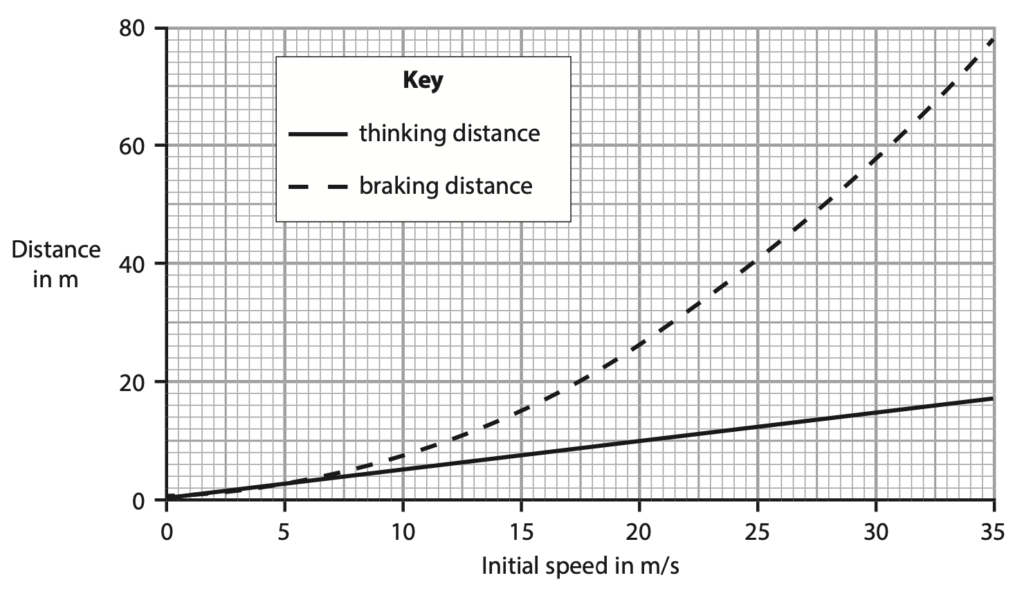
(a) A car has an initial speed of 35 m/s.
The brakes are applied and the car comes to a complete stop in the braking distance shown by the graph.
Calculate the mean braking acceleration of the car. (4)
braking acceleration = ……………………………………………………………………….. m/s2
(b) Evaluate how the thinking distance and the braking distance vary for different values of initial speed.
Refer to information from the graph in your answer. (5)
(Total for Question 11 = 9 marks)
June 2020 Paper 2P Q3
3 The diagram shows some of the forces acting on a large rubbish bin on wheels.
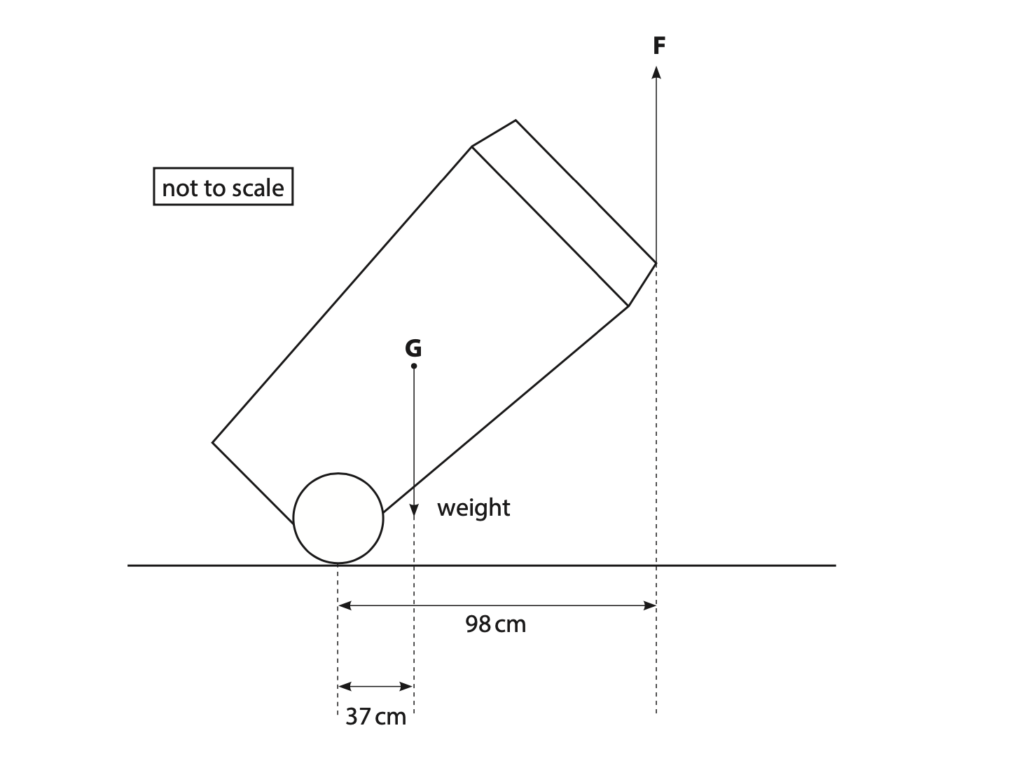
(a) The weight of the bin acts through point G.
Give the name of point G. (1)
(b) The mass of the bin is 23kg.
(i) What is the weight of the bin? (1)
A 23kg
B 230kg
C 230N
D 23000N
(ii) State the principle of moments. (1)
(iii) A person applies force F to the bin to keep it stationary.
Calculate the magnitude of force F. (4)
magnitude of force F = ………………………………………………… N
(iv) State the magnitude and direction of the force applied to the person by the bin. (2)
magnitude = ………………………………………………… N
direction = …………………………………………………
(Total for Question 3 = 9 marks)
June 2020 Paper 2PR Q3
3 A builder needs to lift a large stone block.
(a) Diagram 1 shows the stone block.
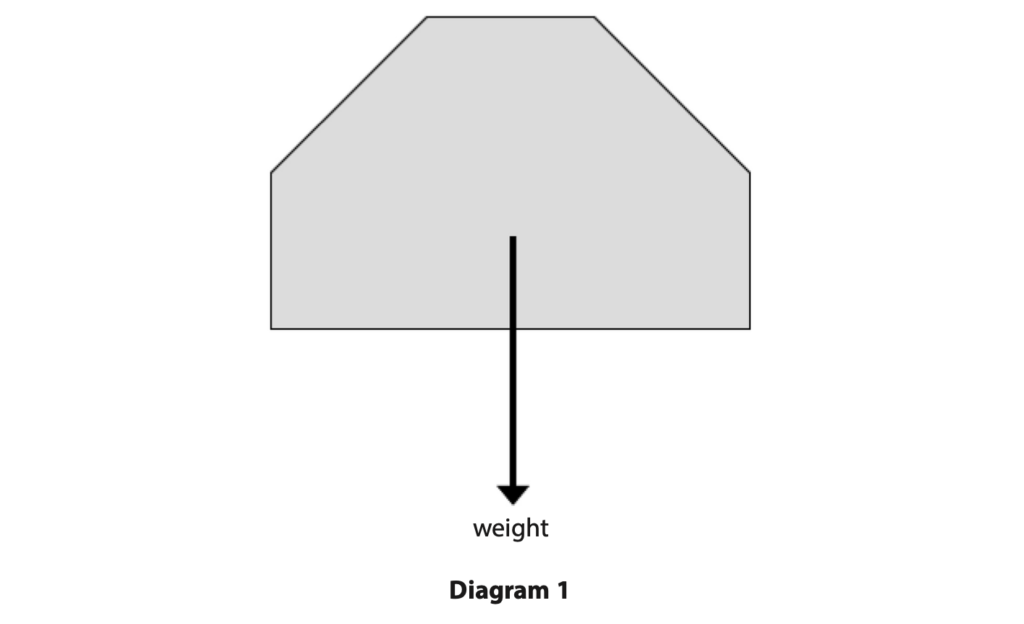
(i) Draw an X on diagram 1 at the centre of gravity of the stone block. (1)
(ii) State the formula linking weight, mass and gravitational field strength. (1)
(iii) The mass of the stone block is 130 kg.
Calculate the weight of the stone block. (2)
weight = ………………………………………………… N
(b) The builder uses a wooden plank to lift the large stone block.
The plank is uniform and pivoted at its centre.
The builder pushes down on one end of the plank to lift the stone block. Diagram 2 shows the plank when it is horizontal and stationary.
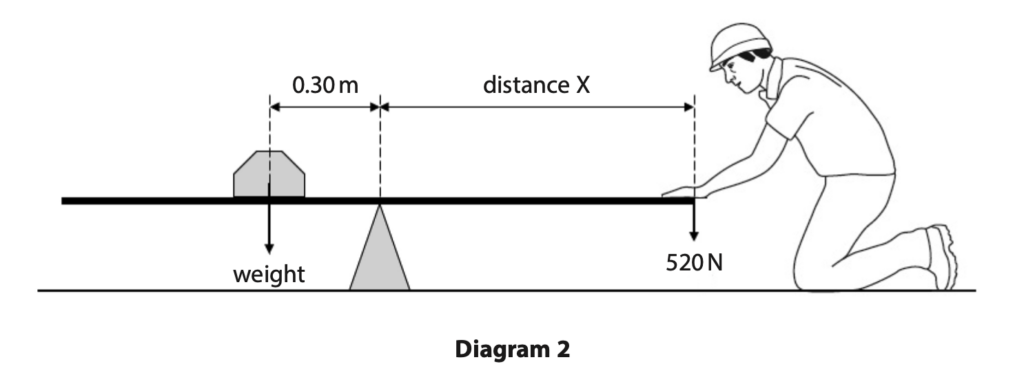
(i) State the principle of moments. (2)
(ii) The builder is pushing down with a force of 520 N to keep the plank horizontal.
Calculate distance X. (3)
distance X = …………………………………………………. m
(iii) Calculate the length of the plank.
length of plank = …………………………………………………. m
(Total for Question 3 = 10 marks)
January 2021 Paper 1P Q2
2 (a) A speed camera is positioned at the side of a road.

The camera measures the speed of a vehicle on the road to determine whether the vehicle is travelling too fast.
The camera takes two photographs of the vehicle 0.25 s apart.
The photographs are used to measure the distance travelled by the vehicle during this time.
(i) State the formula linking average speed, distance moved and time taken. (1)
(ii) In the time between the two photographs, the car travels a distance of 6.5m.
Calculate the average speed of the car. (2)
average speed = …………………………………………………… m/s
(iii) The speed limit of the road is 80 kilometres per hour.
Determine whether the car is exceeding the speed limit. (2)
(b) The velocity-time graph shows how the velocity of a lorry changes with time.
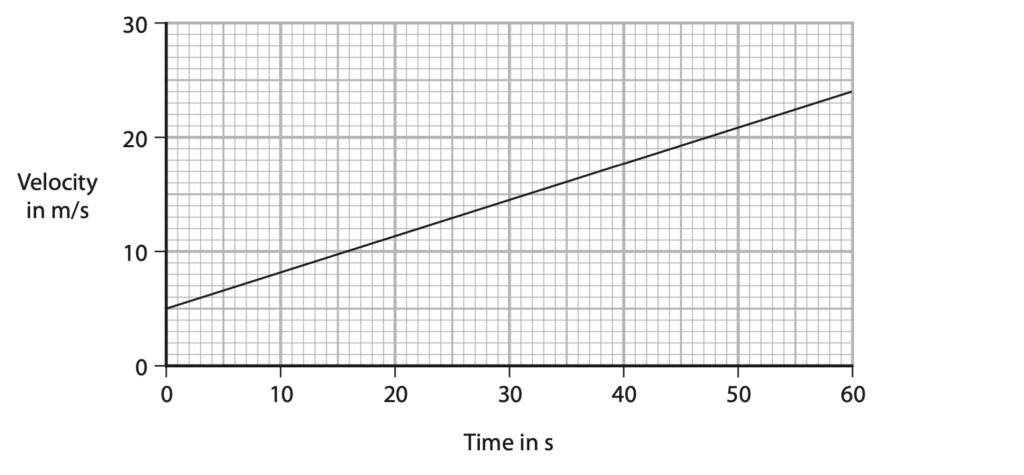
(i) Explain how the graph shows that the lorry has a constant acceleration. (2)
(ii) State the formula linking acceleration, change in velocity and time taken. (1)
(iii) Calculate the acceleration of the lorry. (3)
acceleration = …………………………………………………… m/s2
(Total for Question 2 = 11 marks)
January 2021 Paper 1P Q6
6 When a rubber ball is dropped it hits the floor and bounces.
Design an investigation to determine how the temperature of the rubber ball affects
the maximum height the ball reaches after it bounces.
In your answer, refer to
- how to change the temperature of the ball
- the variables that need to be controlled
- how to obtain high-quality data
You may draw a labelled diagram to support your answer. (6)
(Total for Question 6 = 6 marks)
January 2021 Paper 2P Q3
3 A student uses this apparatus to investigate moments.
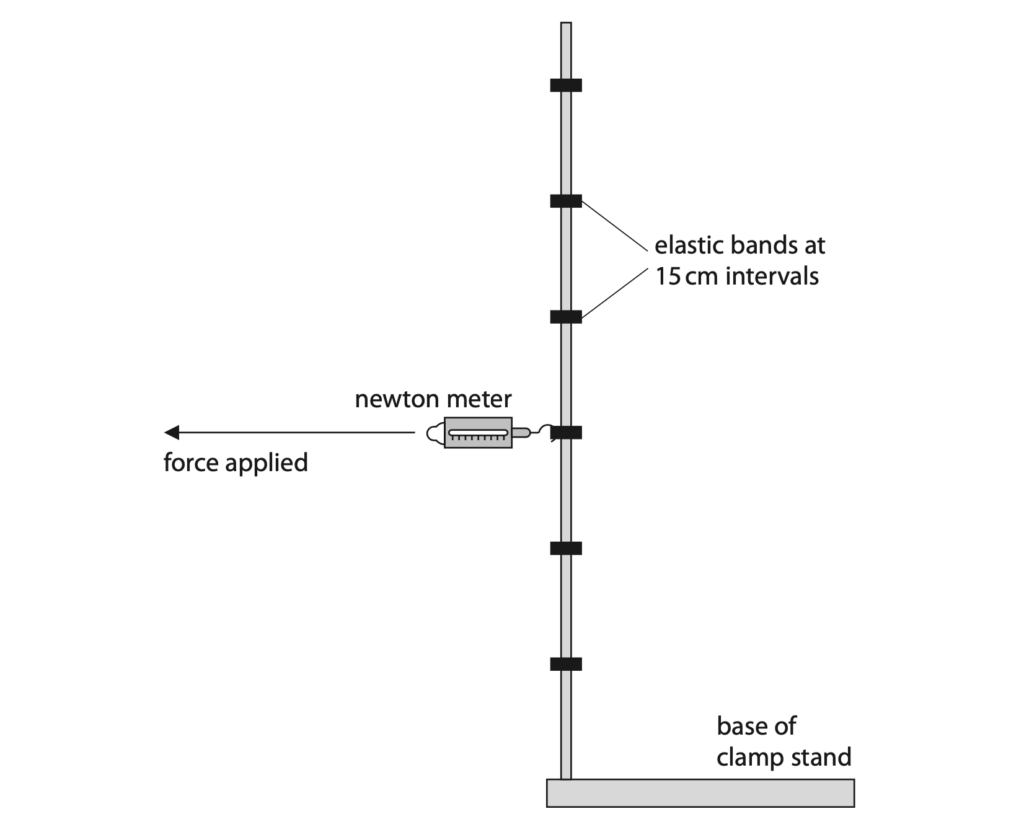
This is the student’s method. force applied
- attach elastic bands at 15 cm intervals on a one metre tall clamp stand
- attach a newton meter to the highest elastic band and measure the horizontal force required to tilt the stand
- repeat the method at each 15 cm interval
(a) Name an instrument that the student should use to accurately measure the distances on the clamp stand. (1)
(b) The table shows the student’s results.
| Distance in cm | Force applied in N |
| 15.0 | 10.0 |
| 30.0 | 5.6 |
| 45.0 | |
| 60.0 | 2.6 |
| 75.0 | 2.2 |
| 90.0 | 1.8 |
(i) The photograph shows the reading on the newton meter when the distance is 45.0 cm.

Use the photograph to determine the force required to tilt the stand when the distance is 45.0 cm. (1)
force = …………………………………………………….. N
(c) (i) Plot a graph of the student’s results on the grid. (ii) Draw the curve of best fit. (3)
(ii) Draw the curve of best fit. (1)
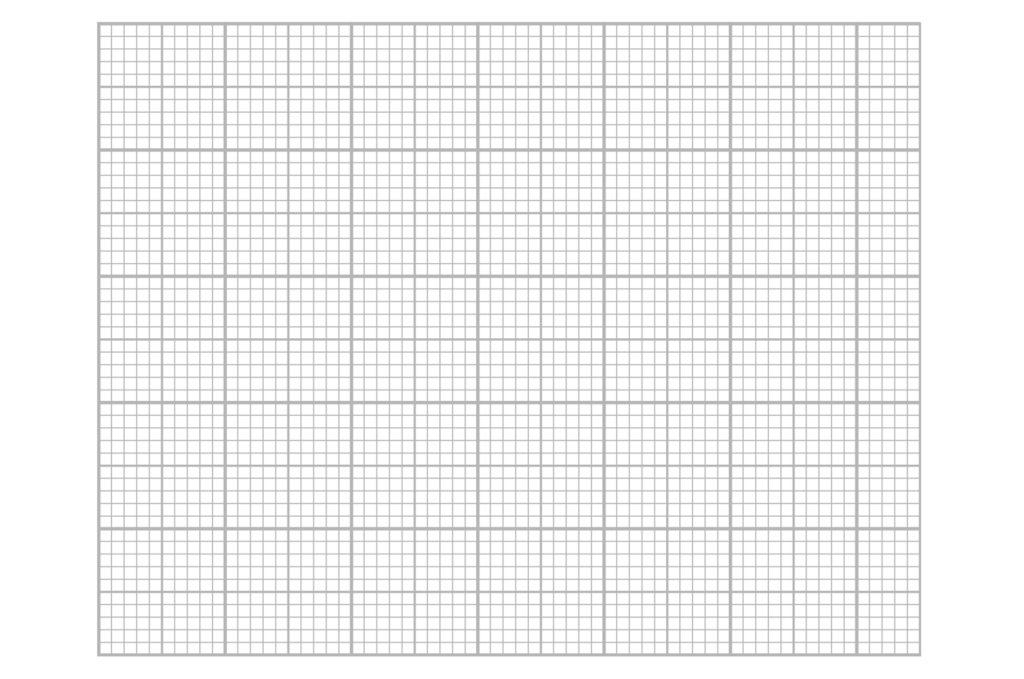
(d) The student concludes that the moment required to tilt the clamp stand does not change when the distance is varied.
Use data from the table or the graph to evaluate the student’s conclusion. (4)
(Total for Question 3 = 11 marks)
January 2021 Paper 2P Q7
7 The diagram shows a child’s toy for accelerating steel balls.

This is how the toy works.
- the toy uses three identical steel balls, each with a mass of 4.1 g
- ball A moves towards the magnet
- ball B is in contact with the magnet
- balls B and C are initially at rest and are in contact with each other
- when ball A collides with the magnet, ball C moves away from the magnet
(a) Ball A moves towards the magnet with an initial velocity of 0.15 m/s.
Calculate the initial momentum of ball A. (2)
initial momentum = …………………………………………………….. kgm/s
(b) Ball A is attracted to the magnet.
Explain how this attraction affects the momentum of ball A as it approaches the magnet (2)
(c) When ball A collides with the magnet, a force of 1.3N is exerted on ball C for a time of 0.0025 s.
This causes ball C to move away from the magnet. Calculate the change in velocity of ball C due to this force. (3)
change in velocity = …………………………………………………….. m/s
(Total for Question 7 = 7 marks)
January 2021 Paper 1PR Q5
5 A student does an investigation to show how the velocity of a toy car changes when the car rolls down a ramp onto a table and hits a wooden block.
The graph shows how the velocity of the toy car changes with time.
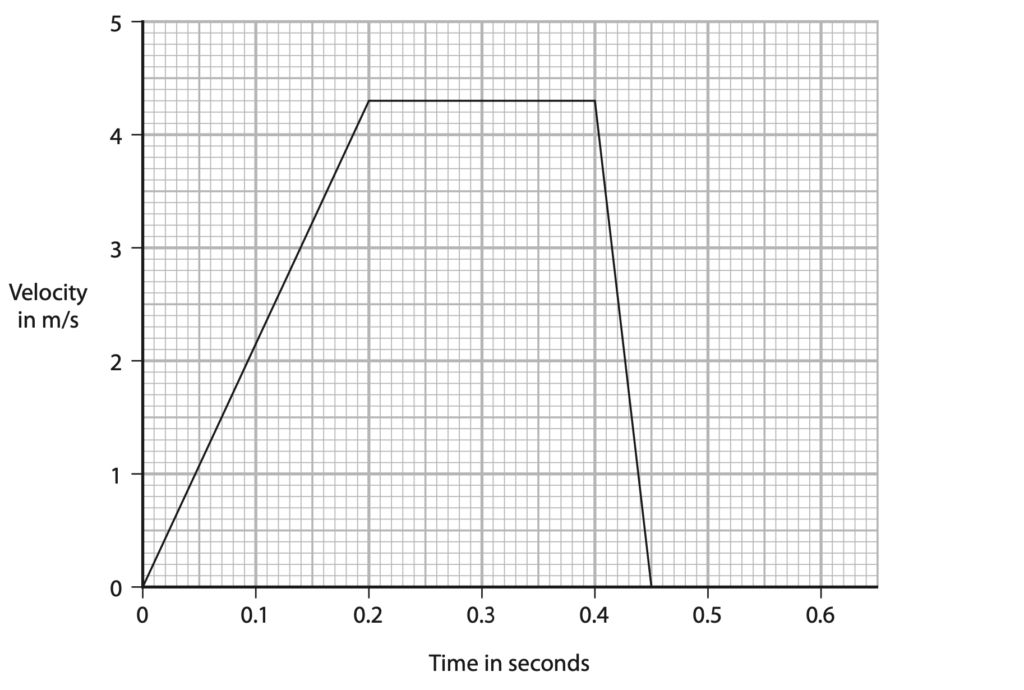
(a) Calculate the distance travelled by the car during the first 0.4 seconds. (4)
distance = …………………………………………………….. m
(b) (i) Calculate the acceleration of the car between 0.40 s and 0.45 s. (3)
acceleration = …………………………………………………….. m/s2
(ii) State the formula linking resultant force, mass and acceleration. (1)
(iii) The car has a mass of 0.13 kg.
Calculate the resultant force on the car as it slows down. (2)
resultant force = …………………………………………………….. N
(c) A piece of soft material is fixed to the front of the toy car.
Explain how this will affect the gradient of the velocity-time graph after the car hits the block. (3)
(Total for Question 5 = 13 marks)
January 2021 Paper 1PR Q11
11 A student uses this apparatus to investigate the force needed to pull a block along a ramp.

(a) (i) State the formula linking work done, force and distance moved in the direction of the force. (1)
(ii) The student pulls the block 0.89m along the ramp with a force of 26N.
Show that the work done on the block by the 26 N force is about 23 J. (2)
(iii) The block has a mass of 1.3 kg and moves vertically upwards 0.11 m.
Calculate the increase in the gravitational potential energy (GPE) store of the block between the bottom and the top of the ramp. (3)
increase in GPE = …………………………………………………….. J
(iv) Explain why the work done to move the block along the ramp is greater than the increase in the GPE store of the block. (2)
(b) The student suggests it is better to use a less steep ramp to raise the block through the same vertical height.
Discuss an advantage and a disadvantage of using a less steep ramp. (4)
(Total for Question 11 = 12 marks)
January 2021 Paper 2PR Q2
2 The diagram shows a metal block on top of a wooden block. The metal block is held stationary by force F.
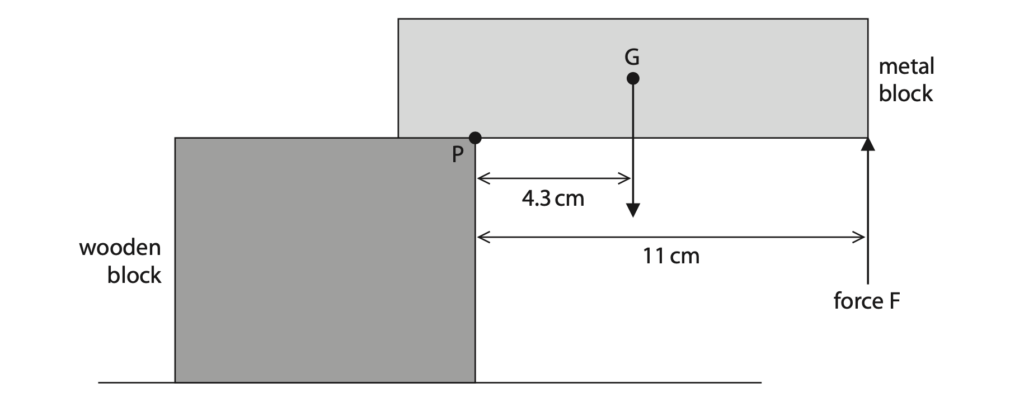
(a) (i) The weight of the metal block acts through point G. Give the name of point G. (1)
(ii) Name a piece of apparatus that could be used to measure the weight of the metal block. (1)
(b) (i) State the formula linking moment, force and perpendicular distance from the pivot. (1)
(ii) The weight of the metal block is 0.68N.
Show that the moment of the weight of the metal block about point P is approximately 2.9 N cm. (1)
(iii) Force F is applied to the metal block to stop it from moving. Calculate the magnitude of force F. (3)
force F = …………………………………………………….. N
(Total for Question 2 = 7 marks)
January 2021 Paper 2PR Q3
3 The diagram shows an air track that can be used to investigate motion without friction.
Air comes out through a series of small holes in the air track, which lifts the gliders slightly above the track.
There are two gliders on the track. Each glider has a magnet.

The poles of the magnets nearest each other are alike.
(a) Explain the direction of the force acting on magnet A from magnet B. (2)
(b) The gliders collide and the magnets cause them to rebound.
Before the collision, the momentum of glider A is 0.045 kg m/s to the right and glider B is at rest.
(i) State the total momentum of glider A and glider B after the collision. (1)
total momentum = …………………………………………………….. kgm/s
(ii) After the collision, the momentumofgliderAis0.021kgm/s to th eleft.
Calculate the momentum of glider B after the collision. (2)
momentum of glider B = …………………………………………………….. kgm/s
(iii) The time taken for glider B to change its momentum is 0.19 seconds.
Calculate the average force on glider B that causes this change in momentum. (2)
average force = …………………………………………………….. N
(iv) Give the direction of the force on glider B from glider A. (1)
(Total for Question 3 = 8 marks)
January 2021 Paper 2PR Q5
5 An aircraft travels along a runway.
(a) The aircraft starts from rest and has a constant acceleration of 4.1 m/s2.
Calculate the distance required to reach take-off speed of 75 m/s. (3)
distance = …………………………………………………….. m
(b) The aircraft takes off and reaches its maximum height above the ground.
At maximum height, the background radiation count rate is higher than on the ground.
(i) Explain what is meant by background radiation. (2)
(ii) Suggest why there is a limit to the number of hours that an airline pilot can fly at maximum height. (3)
(Total for Question 5 = 8 marks)
January 2022 Paper 1P Q5
5 A driver of a car sees an obstruction in the road ahead and must stop the car.
(a) (i) State the formula linking average speed, distance travelled and time taken. (2)
(ii) A car travels at 21m/s.
The driver’s reaction time is 0.14 seconds.
Calculate the distance travelled by the car during the driver’s reaction time. (2)
distance = …………………………………………………….. m
(b) The car experiences a braking force of 7600 N.
The car has a mass of 1200 kg.
(i) State the formula linking force, mass and acceleration. (1)
(ii) Calculate the acceleration of the car.
acceleration = …………………………………………………….. m/s2
(iii) Calculate the braking distance travelled as the speed of the car is reduced from 21m/s to 0m/s. (3)
distance = …………………………………………………….. m
(Total for Question 5 = 9 marks)
January 2022 Paper 1P Q6
6 (a) A person throws an object vertically upwards.
The speed-time graph shows how the speed of the object varies from the time it is thrown until reaching its maximum height.
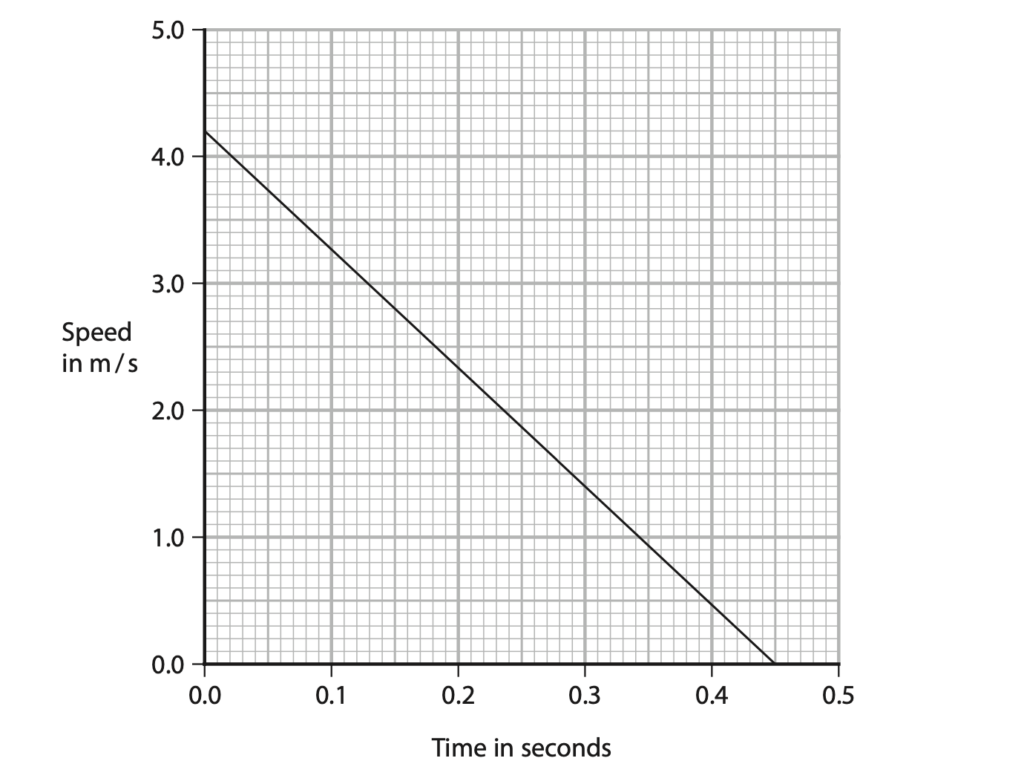
(i) Calculate the acceleration of the object. (3)
acceleration = …………………………………………………….. m/s2
(ii) Calculate the distance the object travels to reach its maximum height. (3)
distance = …………………………………………………….. m
(b) A different object is dropped from rest and begins to fall.
The graph shows how the speed of this object varies with time.
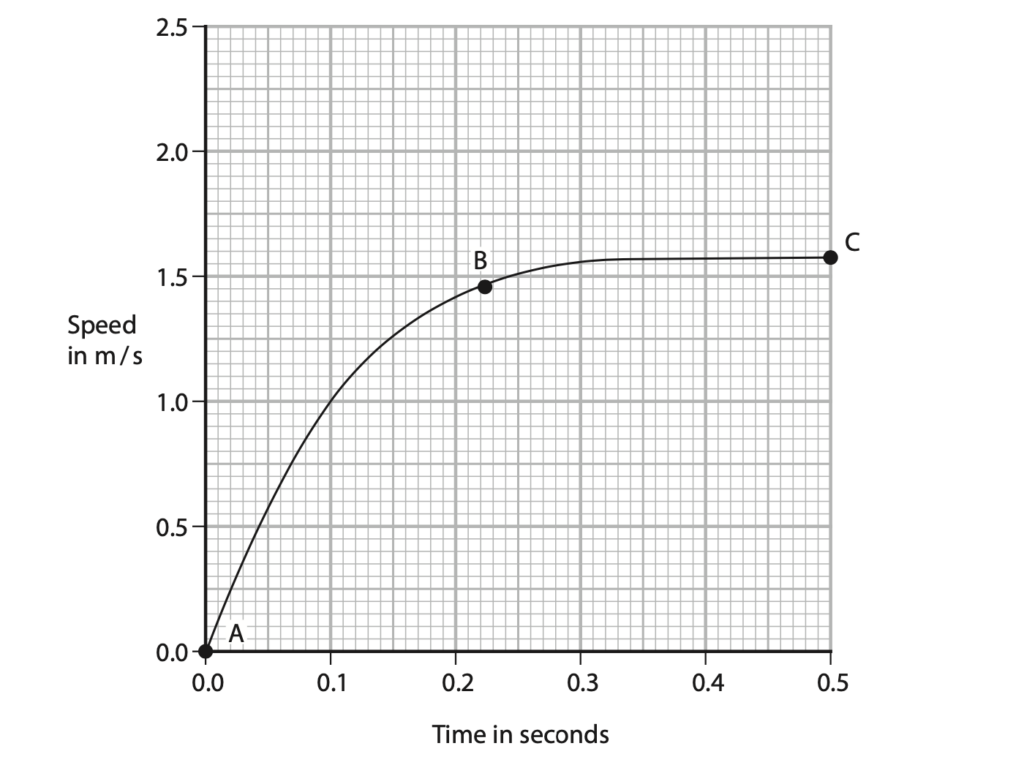
(i) Give the name of the two forces acting on the object as it falls. (2)
1
2
(ii) Draw arrows on the diagram to show the forces acting on the object at B. (3)

(iii) Explain the shape of the graph from A to C.
You should use ideas about forces to help your answer. (4)
(Total for Question 6 = 15 marks)
January 2022 Paper 1P Q9
9 A student investigates how the extension of a spring varies when the mass attached to the spring is changed.
(a) The diagram shows most of the equipment the student uses in the investigation.
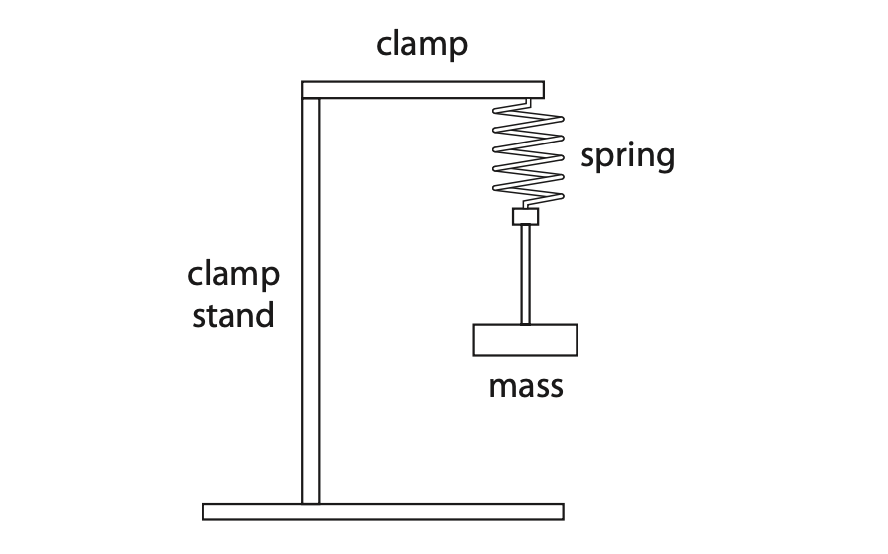
Describe a method the student could use for the investigation.
Your description should include the measurements taken and how the student could obtain accurate results. (5)
(b) The student calculates the force each mass applies to the spring.
The table shows the student’s results.
| Force in N | Extension in cm |
| 0.0 | 0.0 |
| 1.0 | 2.5 |
| 2.0 | 5.0 |
| 3.0 | 9.8 |
| 4.0 | 10.0 |
| 5.0 | 12.5 |
| 6.0 | 15.5 |
| 7.0 | 19.5 |
(i) Plot the student’s results. (3)
(ii) Draw a circle around the anomalous point. (1)
(iii) Draw a line of best fit. (1)
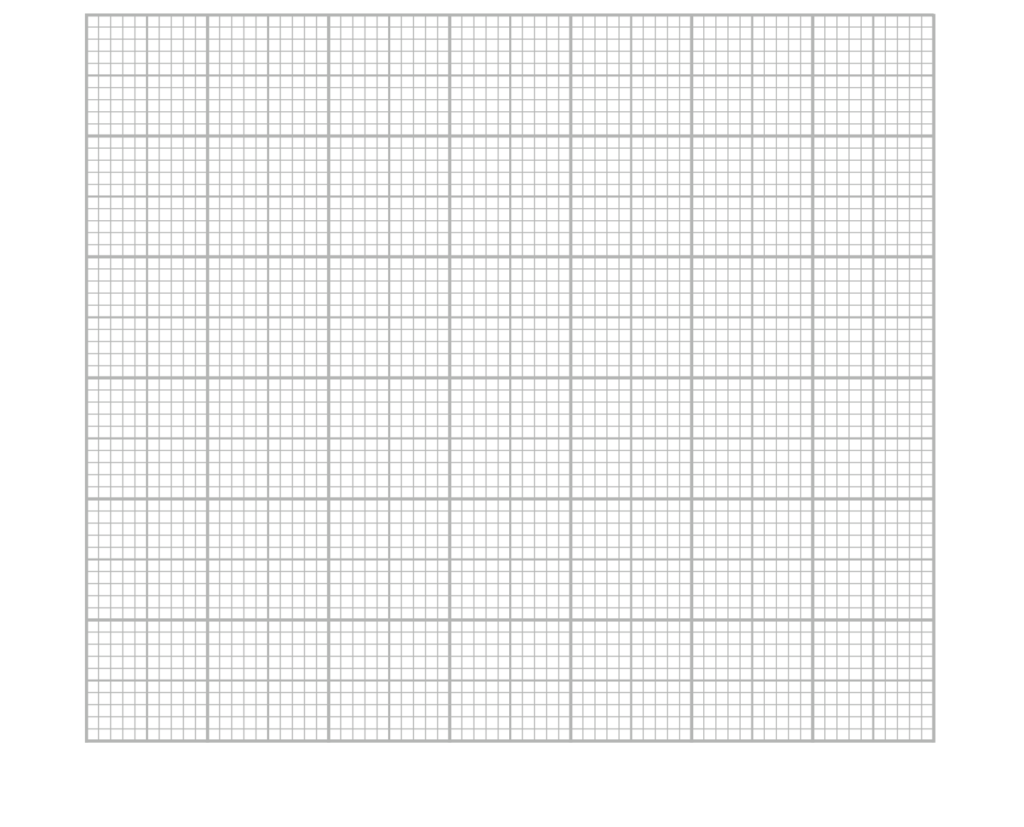
(iv) Explain whether the spring obeys Hooke’s Law. (3)
(Total for Question 9 = 13 marks)
January 2022 Paper 1PR Q4
4 This question is about scalar quantities and vector quantities.
(a) Give a similarity and a difference for scalar quantities and vector quantities. (2)
Similarity
Difference
(b) The box gives some physical quantities.
Draw a circle around each physical quantity that is a scalar. (3)
| Acceleration | charge | force | power |
| temperature | velocity | weight |
(c) The diagram shows four forces acting on an object.
Calculate the size and direction of the resultant force. (2)

resultant force = …………………………………………………….. N
direction = ……………………………………………………..
(Total for Question 4 = 7 marks)
January 2022 Paper 1PR Q10
10 A student does an experiment to determine the acceleration due to gravity, g.
The diagram shows the apparatus used.
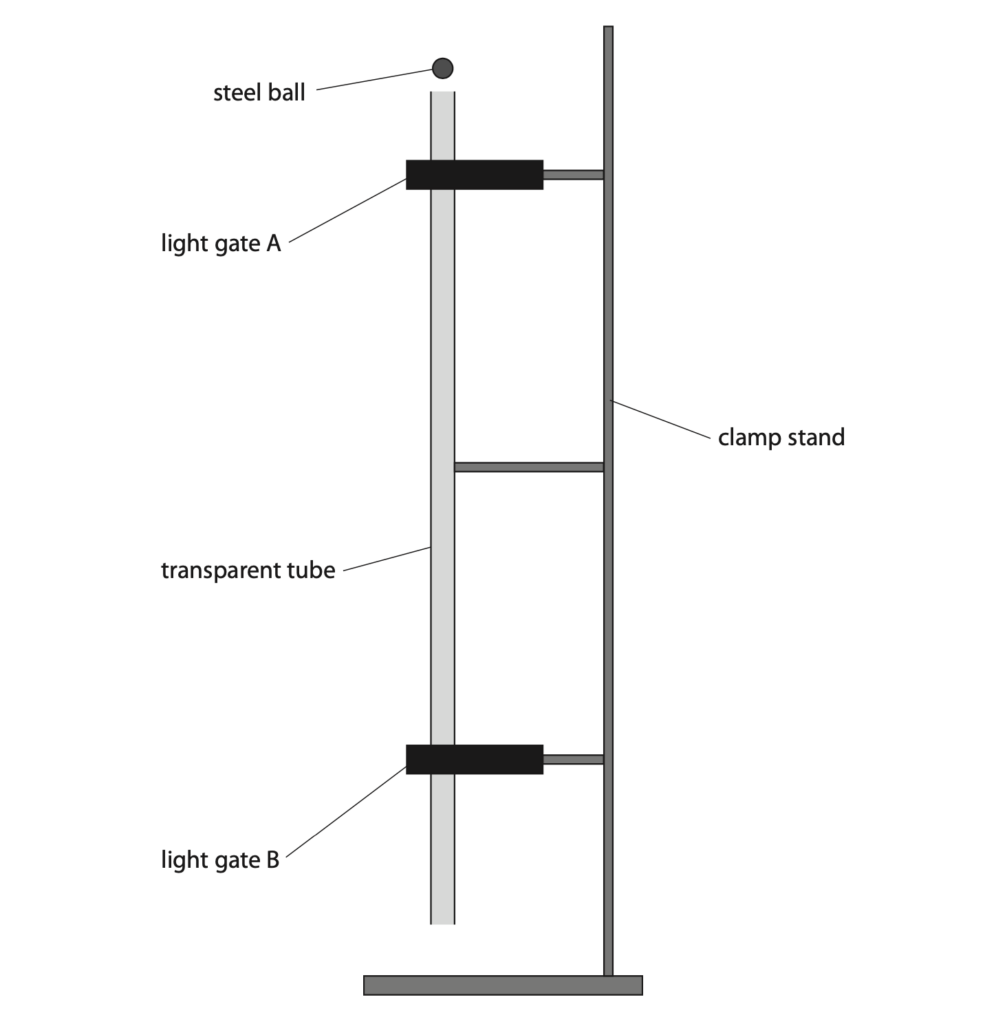
This is the student’s method.
- connect both light gates to a data logger
- drop a steel ball from rest at the top of the transparent tube
- record the speed of the ball at each light gate
- record the time taken for the ball to fall from light gate A to light gate B
(a) The box shows the data recorded by the data logger.
| speed at A = 1.45 m/s speed at B = 4.20 m/s time from A to B = 0.286s |
(i) Show that the acceleration of the steel ball is approximately 9.6 m/s2 . (2)
acceleration = …………………………………………………….. m/s2
(ii) Explain why the student’s value for the acceleration of the steel ball is lower than the accepted value for the acceleration due to gravity, g. (2)
(iii) Calculate the distance between the light gates. (3)
distance = …………………………………………………….. m
(b) The student changes the distance between the light gates by varying the position of light gate B.
The student measures the time taken for the steel ball to fall from light gate A to light gate B when the light gates are different distances apart.
The table shows the student’s results.
| Distance between light gates in m | Time taken in s |
| 0.10 | 0.058 |
| 0.20 | 0.103 |
| 0.30 | 0.141 |
| 0.40 | 0.175 |
| 0.50 | 0.205 |
| 0.60 | 0.233 |
| 0.70 | 0.260 |
(i) Plot a graph of the student’s results on the grid. (2)
(ii) Draw the curve of best fit. (1)

(iii) Explain how the graph shows that the steel ball is accelerating as it falls. (3)
(Total for Question 10 = 13 marks)
January 2022 Paper 2P Q1
1 (a) Which of these is a device used to measure force?
A newton meter
B ruler
C thermometer
D voltmeter
(b) Airbags are safety devices used in cars to protect the driver if there is a crash.
(i) State the formula linking momentum, mass and velocity. (1)
(ii) A person inside a car has a mass of 72 kg and a velocity of 13 m/s.
Show that the momentum of the person is about 900 kg m/s. (1)
(iii) The person experiences a crash and comes to rest in 0.29 s.
Calculate the force on the person. (2)
force = …………………………………………………….. N
(iv) Which statement explains how airbags protect the driver?
A increase the force acting on the driver
B increase the time taken for the driver to stop
C increase the kinetic energy store of the driver
D increase the momentum of the driver
(Total for Question 1 = 6 marks)
January 2022 Paper 2P Q5
5 The diagram shows a ball at the bottom of a ramp. The ball moves up the ramp with an initial speed v.

(a) State the formula linking gravitational potential energy (GPE), mass, gravitational field strength (g) and height. (1)
(b) The ball has a mass of 14 g.
Show that when the ball reaches a height of 29 cm above the bottom of the ramp, the GPE gained by the ball is about 4 × 10−2 J. (3)
(c) At the bottom of the ramp, the 14 g ball has a kinetic energy (KE) of 5.1 × 10−2 J.
Calculate the speed of the ball at the bottom of the ramp. (3)
speed = …………………………………………………….. m/s
(d) The ball is stationary when it reaches the top of the ramp. There is a difference between the KE of the ball at the bottom of the ramp and the GPE of the ball at a height of 29 cm above the bottom of the ramp.
Explain why the work done by friction between the ball and the ramp is equal to this difference. (2)
(Total for Question 5 = 9 marks)
January 2022 Paper 2PR Q2
2 Cricket is a sport played with bats and balls.
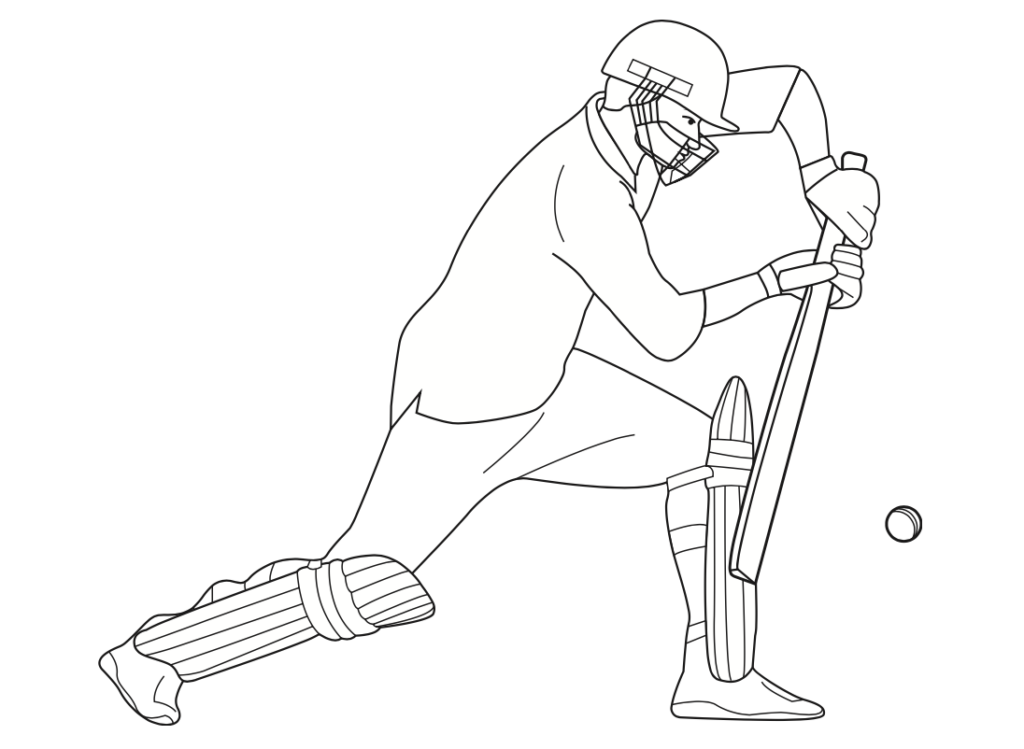
(a) (i) A cricket player hits a ball with a bat. Before the ball is hit, it is moving to the left with a momentum of 4.2 kg m/s.
The bat is in contact with the ball for 0.012 s.
After the ball is hit, it moves to the right with a momentum of 6.7 kg m/s.
Calculate the mean force the bat exerts on the ball and state the direction of the force. (3)
mean force = ……………………………………….. N
direction ………………………………………..
(b) The cricket player wears padded protective equipment.
This protective equipment reduces the risk of injury to the player if they are struck by the cricket ball.
Explain how this protective equipment reduces the risk of injury to the player.
Use ideas about momentum in your answer. (3)
(Total for Question 2 = 7 marks)
You can find more IGCSE Physics Past Year Questions by the Wave topic below:




